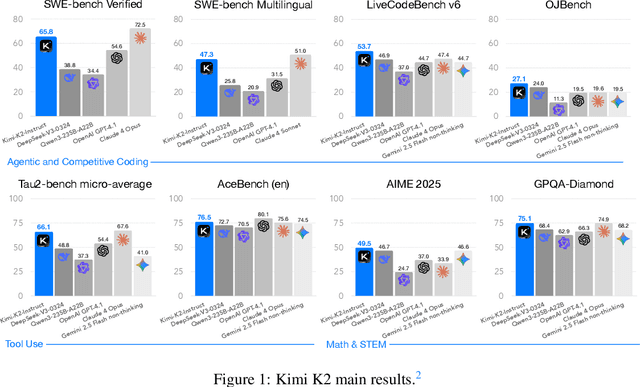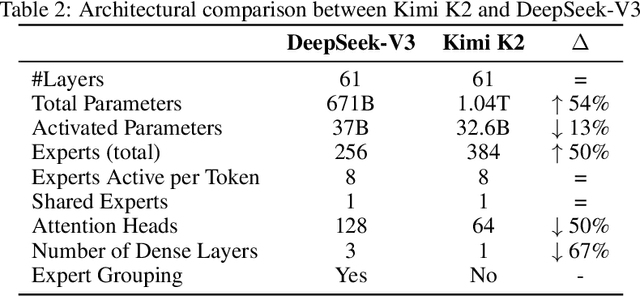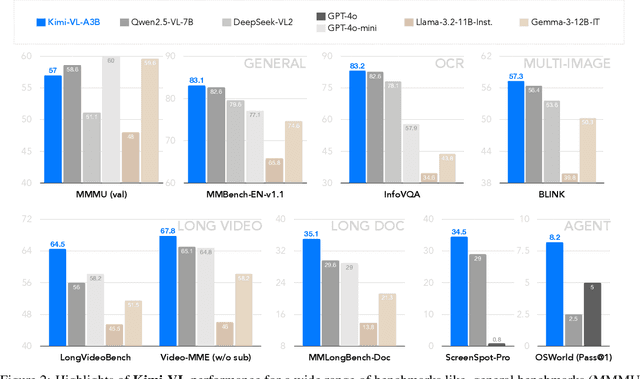Yibo Liu
Seedance 1.5 pro: A Native Audio-Visual Joint Generation Foundation Model
Dec 23, 2025Abstract:Recent strides in video generation have paved the way for unified audio-visual generation. In this work, we present Seedance 1.5 pro, a foundational model engineered specifically for native, joint audio-video generation. Leveraging a dual-branch Diffusion Transformer architecture, the model integrates a cross-modal joint module with a specialized multi-stage data pipeline, achieving exceptional audio-visual synchronization and superior generation quality. To ensure practical utility, we implement meticulous post-training optimizations, including Supervised Fine-Tuning (SFT) on high-quality datasets and Reinforcement Learning from Human Feedback (RLHF) with multi-dimensional reward models. Furthermore, we introduce an acceleration framework that boosts inference speed by over 10X. Seedance 1.5 pro distinguishes itself through precise multilingual and dialect lip-syncing, dynamic cinematic camera control, and enhanced narrative coherence, positioning it as a robust engine for professional-grade content creation. Seedance 1.5 pro is now accessible on Volcano Engine at https://console.volcengine.com/ark/region:ark+cn-beijing/experience/vision?type=GenVideo.
Kimi Linear: An Expressive, Efficient Attention Architecture
Oct 30, 2025Abstract:We introduce Kimi Linear, a hybrid linear attention architecture that, for the first time, outperforms full attention under fair comparisons across various scenarios -- including short-context, long-context, and reinforcement learning (RL) scaling regimes. At its core lies Kimi Delta Attention (KDA), an expressive linear attention module that extends Gated DeltaNet with a finer-grained gating mechanism, enabling more effective use of limited finite-state RNN memory. Our bespoke chunkwise algorithm achieves high hardware efficiency through a specialized variant of the Diagonal-Plus-Low-Rank (DPLR) transition matrices, which substantially reduces computation compared to the general DPLR formulation while remaining more consistent with the classical delta rule. We pretrain a Kimi Linear model with 3B activated parameters and 48B total parameters, based on a layerwise hybrid of KDA and Multi-Head Latent Attention (MLA). Our experiments show that with an identical training recipe, Kimi Linear outperforms full MLA with a sizeable margin across all evaluated tasks, while reducing KV cache usage by up to 75% and achieving up to 6 times decoding throughput for a 1M context. These results demonstrate that Kimi Linear can be a drop-in replacement for full attention architectures with superior performance and efficiency, including tasks with longer input and output lengths. To support further research, we open-source the KDA kernel and vLLM implementations, and release the pre-trained and instruction-tuned model checkpoints.
Emergent Crowds Dynamics from Language-Driven Multi-Agent Interactions
Aug 20, 2025Abstract:Animating and simulating crowds using an agent-based approach is a well-established area where every agent in the crowd is individually controlled such that global human-like behaviour emerges. We observe that human navigation and movement in crowds are often influenced by complex social and environmental interactions, driven mainly by language and dialogue. However, most existing work does not consider these dimensions and leads to animations where agent-agent and agent-environment interactions are largely limited to steering and fixed higher-level goal extrapolation. We propose a novel method that exploits large language models (LLMs) to control agents' movement. Our method has two main components: a dialogue system and language-driven navigation. We periodically query agent-centric LLMs conditioned on character personalities, roles, desires, and relationships to control the generation of inter-agent dialogue when necessitated by the spatial and social relationships with neighbouring agents. We then use the conversation and each agent's personality, emotional state, vision, and physical state to control the navigation and steering of each agent. Our model thus enables agents to make motion decisions based on both their perceptual inputs and the ongoing dialogue. We validate our method in two complex scenarios that exemplify the interplay between social interactions, steering, and crowding. In these scenarios, we observe that grouping and ungrouping of agents automatically occur. Additionally, our experiments show that our method serves as an information-passing mechanism within the crowd. As a result, our framework produces more realistic crowd simulations, with emergent group behaviours arising naturally from any environmental setting.
Kimi K2: Open Agentic Intelligence
Jul 28, 2025



Abstract:We introduce Kimi K2, a Mixture-of-Experts (MoE) large language model with 32 billion activated parameters and 1 trillion total parameters. We propose the MuonClip optimizer, which improves upon Muon with a novel QK-clip technique to address training instability while enjoying the advanced token efficiency of Muon. Based on MuonClip, K2 was pre-trained on 15.5 trillion tokens with zero loss spike. During post-training, K2 undergoes a multi-stage post-training process, highlighted by a large-scale agentic data synthesis pipeline and a joint reinforcement learning (RL) stage, where the model improves its capabilities through interactions with real and synthetic environments. Kimi K2 achieves state-of-the-art performance among open-source non-thinking models, with strengths in agentic capabilities. Notably, K2 obtains 66.1 on Tau2-Bench, 76.5 on ACEBench (En), 65.8 on SWE-Bench Verified, and 47.3 on SWE-Bench Multilingual -- surpassing most open and closed-sourced baselines in non-thinking settings. It also exhibits strong capabilities in coding, mathematics, and reasoning tasks, with a score of 53.7 on LiveCodeBench v6, 49.5 on AIME 2025, 75.1 on GPQA-Diamond, and 27.1 on OJBench, all without extended thinking. These results position Kimi K2 as one of the most capable open-source large language models to date, particularly in software engineering and agentic tasks. We release our base and post-trained model checkpoints to facilitate future research and applications of agentic intelligence.
Bayesian Optimization for Enhanced Language Models: Optimizing Acquisition Functions
May 22, 2025Abstract:With the rise of different language model architecture, fine-tuning is becoming even more important for down stream tasks Model gets messy, finding proper hyperparameters for fine-tuning. Although BO has been tried for hyperparameter tuning, most of the existing methods are oblivious to the fact that BO relies on careful choices of acquisition functions, which are essential components of BO that guide how much to explore versus exploit during the optimization process; Different acquisition functions have different levels of sensitivity towards training loss and validation performance; existing methods often just apply an acquisition function no matter if the training and validation performance are sensitive to the acquisition function or not. This work introduces{Bilevel - BO - SWA}, a model fusion approach coupled with a bilevel BO strategy to improve the fine - tunning of large language models. Our work on mixture of acquisition functions like EI and UCB into nested opt loops, where inner loop perform minimization of training loss while outer loops optimized w.r.t. val metric. Experiments on GLUE tasks using RoBERTA - base show that when using EI and UCB, there is an improvement in generalization, and fine - tuning can be improved by up to 2.7%.
Neural Kinematic Bases for Fluids
Apr 22, 2025



Abstract:We propose mesh-free fluid simulations that exploit a kinematic neural basis for velocity fields represented by an MLP. We design a set of losses that ensures that these neural bases satisfy fundamental physical properties such as orthogonality, divergence-free, boundary alignment, and smoothness. Our neural bases can then be used to fit an input sketch of a flow, which will inherit the same fundamental properties from the bases. We then can animate such flow in real-time using standard time integrators. Our neural bases can accommodate different domains and naturally extend to three dimensions.
Kimi-VL Technical Report
Apr 10, 2025



Abstract:We present Kimi-VL, an efficient open-source Mixture-of-Experts (MoE) vision-language model (VLM) that offers advanced multimodal reasoning, long-context understanding, and strong agent capabilities - all while activating only 2.8B parameters in its language decoder (Kimi-VL-A3B). Kimi-VL demonstrates strong performance across challenging domains: as a general-purpose VLM, Kimi-VL excels in multi-turn agent tasks (e.g., OSWorld), matching flagship models. Furthermore, it exhibits remarkable capabilities across diverse challenging vision language tasks, including college-level image and video comprehension, OCR, mathematical reasoning, and multi-image understanding. In comparative evaluations, it effectively competes with cutting-edge efficient VLMs such as GPT-4o-mini, Qwen2.5-VL-7B, and Gemma-3-12B-IT, while surpassing GPT-4o in several key domains. Kimi-VL also advances in processing long contexts and perceiving clearly. With a 128K extended context window, Kimi-VL can process diverse long inputs, achieving impressive scores of 64.5 on LongVideoBench and 35.1 on MMLongBench-Doc. Its native-resolution vision encoder, MoonViT, further allows it to see and understand ultra-high-resolution visual inputs, achieving 83.2 on InfoVQA and 34.5 on ScreenSpot-Pro, while maintaining lower computational cost for common tasks. Building upon Kimi-VL, we introduce an advanced long-thinking variant: Kimi-VL-Thinking. Developed through long chain-of-thought (CoT) supervised fine-tuning (SFT) and reinforcement learning (RL), this model exhibits strong long-horizon reasoning capabilities. It achieves scores of 61.7 on MMMU, 36.8 on MathVision, and 71.3 on MathVista while maintaining the compact 2.8B activated LLM parameters, setting a new standard for efficient multimodal thinking models. Code and models are publicly accessible at https://github.com/MoonshotAI/Kimi-VL.
Muon is Scalable for LLM Training
Feb 24, 2025Abstract:Recently, the Muon optimizer based on matrix orthogonalization has demonstrated strong results in training small-scale language models, but the scalability to larger models has not been proven. We identify two crucial techniques for scaling up Muon: (1) adding weight decay and (2) carefully adjusting the per-parameter update scale. These techniques allow Muon to work out-of-the-box on large-scale training without the need of hyper-parameter tuning. Scaling law experiments indicate that Muon achieves $\sim\!2\times$ computational efficiency compared to AdamW with compute optimal training. Based on these improvements, we introduce Moonlight, a 3B/16B-parameter Mixture-of-Expert (MoE) model trained with 5.7T tokens using Muon. Our model improves the current Pareto frontier, achieving better performance with much fewer training FLOPs compared to prior models. We open-source our distributed Muon implementation that is memory optimal and communication efficient. We also release the pretrained, instruction-tuned, and intermediate checkpoints to support future research.
Mapping and Localization Using LiDAR Fiducial Markers
Feb 05, 2025



Abstract:LiDAR sensors are essential for autonomous systems, yet LiDAR fiducial markers (LFMs) lag behind visual fiducial markers (VFMs) in adoption and utility. Bridging this gap is vital for robotics and computer vision but challenging due to the sparse, unstructured nature of 3D LiDAR data and 2D-focused fiducial marker designs. This dissertation proposes a novel framework for mapping and localization using LFMs is proposed to benefit a variety of real-world applications, including the collection of 3D assets and training data for point cloud registration, 3D map merging, Augmented Reality (AR), and many more. First, an Intensity Image-based LiDAR Fiducial Marker (IFM) system is introduced, using thin, letter-sized markers compatible with VFMs. A detection method locates 3D fiducials from intensity images, enabling LiDAR pose estimation. Second, an enhanced algorithm extends detection to 3D maps, increasing marker range and facilitating tasks like 3D map merging. This method leverages both intensity and geometry, overcoming limitations of geometry-only detection approaches. Third, a new LFM-based mapping and localization method registers unordered, low-overlap point clouds. It employs adaptive threshold detection and a two-level graph framework to solve a maximum a-posteriori (MAP) problem, optimizing point cloud and marker poses. Additionally, the Livox-3DMatch dataset is introduced, improving learning-based multiview point cloud registration methods. Extensive experiments with various LiDAR models in diverse indoor and outdoor scenes demonstrate the effectiveness and superiority of the proposed framework.
UniGaussian: Driving Scene Reconstruction from Multiple Camera Models via Unified Gaussian Representations
Nov 22, 2024



Abstract:Urban scene reconstruction is crucial for real-world autonomous driving simulators. Although existing methods have achieved photorealistic reconstruction, they mostly focus on pinhole cameras and neglect fisheye cameras. In fact, how to effectively simulate fisheye cameras in driving scene remains an unsolved problem. In this work, we propose UniGaussian, a novel approach that learns a unified 3D Gaussian representation from multiple camera models for urban scene reconstruction in autonomous driving. Our contributions are two-fold. First, we propose a new differentiable rendering method that distorts 3D Gaussians using a series of affine transformations tailored to fisheye camera models. This addresses the compatibility issue of 3D Gaussian splatting with fisheye cameras, which is hindered by light ray distortion caused by lenses or mirrors. Besides, our method maintains real-time rendering while ensuring differentiability. Second, built on the differentiable rendering method, we design a new framework that learns a unified Gaussian representation from multiple camera models. By applying affine transformations to adapt different camera models and regularizing the shared Gaussians with supervision from different modalities, our framework learns a unified 3D Gaussian representation with input data from multiple sources and achieves holistic driving scene understanding. As a result, our approach models multiple sensors (pinhole and fisheye cameras) and modalities (depth, semantic, normal and LiDAR point clouds). Our experiments show that our method achieves superior rendering quality and fast rendering speed for driving scene simulation.
 Add to Chrome
Add to Chrome Add to Firefox
Add to Firefox Add to Edge
Add to Edge